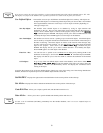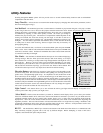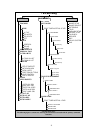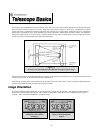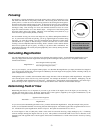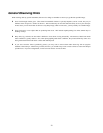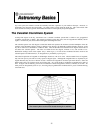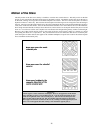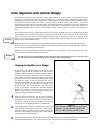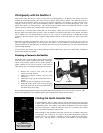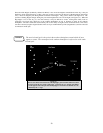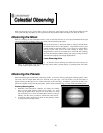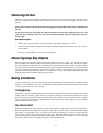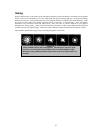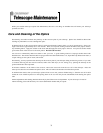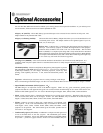
27
P
P
o
o
l
l
a
a
r
r
A
A
l
l
i
i
g
g
n
n
m
m
e
e
n
n
t
t
(
(
w
w
i
i
t
t
h
h
o
o
p
p
t
t
i
i
o
o
n
n
a
a
l
l
W
W
e
e
d
d
g
g
e
e
)
)
Even though the NexStar can precisely track a celestial object while in the Alt-Az position, it is still necessary to align
the polar axis of the telescope (the fork arm) to the Earth's axis on rotation in order to attempt long exposure astro
photography. To do an accurate polar alignment, the NexStar requires an optional equatorial wedge (#93658) between
the telescope and a tripod. Celestron also offers a steel tripod with an attached wedge tilt plate (#93497). This allows
the telescope's tracking motors to rotate the telescope around the celestial pole, the same way as the stars. Without the
equatorial wedge, you would notice the stars in the eyepiece would slowly rotate around the center of the field of view.
Although this gradual rotation would go unnoticed when viewing with an eyepiece, it would be very noticeable on
film.
Polar alignment is the process by which the telescope's axis of rotation (called the polar axis) is aligned (made parallel)
with the Earth's axis of rotation. Once aligned, a telescope with a clock drive will track the stars as they move across
the sky. The result is that objects observed through the telescope appear stationary (i.e., they will not drift out of the
field of view). If not using the clock drive, all objects in the sky (day or night) will slowly drift out of the field. This
motion is caused by the Earth's rotation.
Remember, whenever attaching the NexStar to the NexStar tripod or wedge, always use the bolts that come with the
accessory. Never use bolts that thread more than 3/8" into the bottom of the NexStar base. Threading bolts more than
3/8" into the base will damage the internal gears.
Whether you are using your NexStar in the Alt-Az configuration or polar aligned, it will be necessary to locate where
north is and more specifically where the North Star is.
The polar axis is the axis around which the telescope rotates when moved in right ascension. This axis points
the same direction even when the telescope moves in right ascension and declination.
A
A
l
l
i
i
g
g
n
n
i
i
n
n
g
g
t
t
h
h
e
e
N
N
e
e
x
x
S
S
t
t
a
a
r
r
4
4
o
o
n
n
a
a
W
W
e
e
d
d
g
g
e
e
In order to do a star alignment while using the NexStar on an
equatorial wedge it will be necessary to use the Two-Star
alignment method rather than the AutoAlign method. Before
the NexStar is attached to the wedge, slew the telescope so
that the tube is pointed straight up overhead (the tube should
be parallel to the fork arm). Attach the telescope to the wedge
and angle the wedge so that the NexStar's fork arm is
pointing towards Polaris. Move the tripod side to side and tilt
the wedge up and down until Polaris is aligned in the
StarPointer and visible in the eyepiece. Now recycle the
power on the NexStar and begin the Two-Star alignment
procedure as described in the Hand Control section of the
manual. When doing a Two-Star alignment while using an
equatorial wedge, remember the following:
When the hand control instructs you to point the telescope
tube north and level, make sure that the tube is positioned
perpendicular (at a 90º angle) to the fork arm with the tube
facing down. This is the same position that you would have
the tube if you were aligning the telescope in Altazimuth.
After the alignment is complete, remember that your slew and
filter limits are defined relative to the base of the telescope.
This means that an altitude slew limit of 80º instructs the
NexStar to avoid slewing to any objects that is closer than 10º
from being parallel with the fork arm.
Filter limits should be set so that the entire database will be displayed. Set the maximum altitude limit to read 90º and
the minimum altitude limit to –90º. This will allow you to view and choose any object in the database.
Definition
Figure 6-3
This is how the telescope is to be set up for polar
alignment. The tube should be parallel to the
fork arm which should be pointed to Polaris.
Warning!



